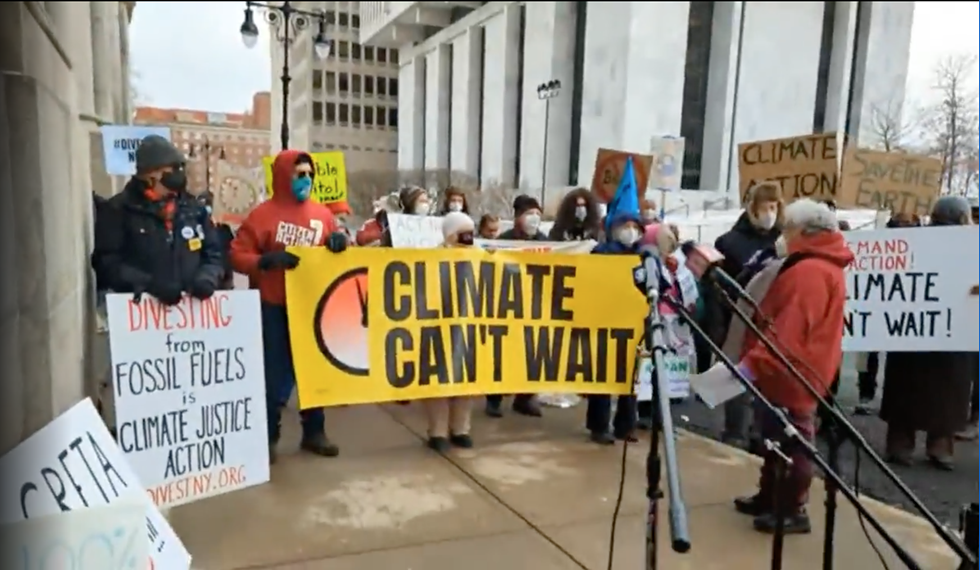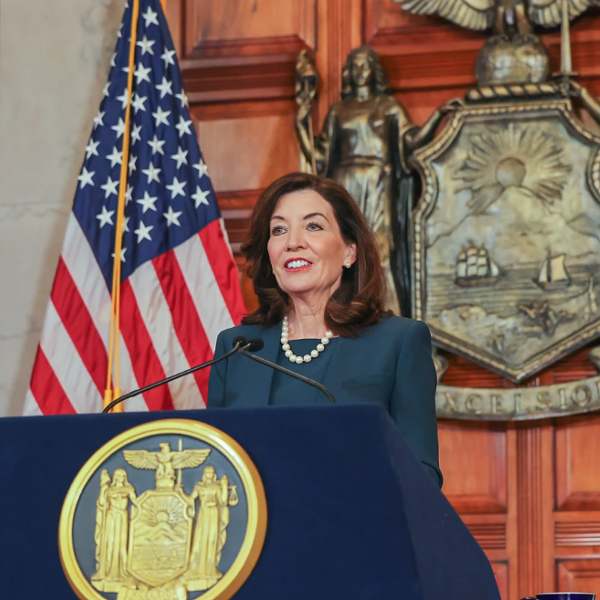Climate action has been on pause in the New York State Legislature since 2019. Could this be the year that changes?
On January 25, a group of 38 state climate and community organizations held a press conference outside the Capitol building in Albany to press for the passage of a slate of climate legislation, dubbed “Climate Can’t Wait 2022.” Activists also held rallies in Manhattan and Yonkers in support of the agenda.
New York lawmakers made waves in 2019 with the passage of a bold climate bill aimed at decarbonizing the state economy and addressing longstanding environmental justice issues in communities, the Climate Leadership and Community Protection Act (CLCPA). But since then, the state legislature has been stuck in a holding pattern on climate, with most of the bills that would translate the CLCPA’s goals into concrete action tied up in committee in either the Senate, the Assembly, or both. Last year, despite a raft of potential bills and a push by climate groups for action on them, the only significant climate-related bills that became law were the Soil Health and Climate Resiliency Act (an uncontroversial piece of legislation aimed at boosting climate-friendly agricultural practices) and a bill that set a goal for all new passenger vehicle sales in New York to be electric by 2035 (which needs yet-to-be-adopted regulations and enforcement in order to be effective).
This year might be different. Governor Kathy Hochul is backing a ban on fossil fuels in new construction by 2027, a goal she pressed for in her State of the State address on January 5. Since taking office, she has spoken much more clearly and specifically about climate and the need to decarbonize than her predecessor Andrew Cuomo did. There’s also new pressure on legislators to act in 2022: On January 1, the state Climate Action Council (CAC), a 22-member body created by the CLCPA, released its long-anticipated draft scoping plan for decarbonizing the state economy by 2050, and will adopt a final version of the plan later this year. Turning the CAC’s roadmap for New York’s clean energy transition into real action will require a lot of supportive legislation, and the clock is ticking.
If the budget proposed by Hochul for 2022 stays mostly intact, climate advocates will be sorely disappointed. Among the biggest issues for the climate crew: Hochul’s budget has no plans for raising new revenue to tackle tough decarbonization and clean energy transition problems, a project state analysts say will cost something on the order of $10 to $15 billion a year in the near term.
But as the CLCPA’s deadlines loom nearer, lawmakers are showing signs of engaging more seriously with its targets. On Tuesday, February 1, a state budget hearing devoted to environmental conservation topics ran for 14 hours, a grueling marathon of testimony on energy and environment issues that drew pointed questions from many state legislators.
Below, we take a look at the bills climate advocates want to see passed this year—and a few other important bills that aren’t on the Climate Can’t Wait agenda, but might be critical for New York to reach its climate and energy goals.
Money for Climate
Climate organizing is messy. With shifting alliances between old-guard environmentalists, multiracial community organizations, labor unions, climate tech entrepreneurs, progressives, and other groups, there’s a lot that advocates don’t see eye to eye on. But on this, they tend to agree: Climate solutions need a lot more funding than New York is currently devoting. And with federal climate funding stalled out by the failure of Congress to pass the Build Back Better bill, New York State may have to raise most of that money itself.
Advocates see two main possible paths for raising new revenue to fund programs aimed at the zero-carbon energy transition, energy efficiency, green jobs, and environmental justice. One is a carbon tax, which would require major polluters to pay for their greenhouse gas emissions, and could also fund a dividend paid directly to low- and moderate-income New Yorkers to offset any increase in energy prices that the tax might cause. The other is a new wealth tax on the state’s highest earners, an approach favored by “Green New Deal” proponents.
Rather than pick one path, the Climate Can’t Wait coalition put both in its platform. The agenda calls for the passage of the Climate and Community Investment Act, a carbon tax bill that would raise $15 billion from polluter emissions fees and give a third of it directly back to New York households. Also included in the advocates’ agenda is the “Green New Deal for New York Act,” a $10 billion wealth tax that does not (yet?) have a piece of legislation filed.
Funding of some sort is the most urgent priority, says Stephan Edel, spokesperson for the climate coalition NY Renews. “The legislature needs to own finding that money,” he says. “If they want to find it from polluters, fine. If they want to find it from rich people, go for it. What matters is that they find money on this scale.”
In a recent press conference on climate funding held by NY Renews, several state lawmakers spoke in support of putting more decarbonization funding in the budget. “We have to fund the promises we made in the CLCPA,” said state Senator Samra Brouk of Western New York’s 55th district. “The best time to do that was 10, 20, 30, 50 years ago. The second best time is now.”
“If we can find $1 billion for potholes, we can find $15 billion for the climate crisis,” said Bronx Assembly member Kenny Burgos, one of multiple lawmakers at the climate press conference who took a dig at Hochul’s “war on potholes” in the executive budget.
“The legislature needs to own finding that money. If they want to find it from polluters, fine. If they want to find it from rich people, go for it. What matters is that they find money on this scale.”
Stephan Edel, NY RenewsDuring the environmental conservation state budget hearing, Senate energy and telecommunications committee chair Kevin Parker—a Brooklyn Democrat who has been dubbed “the Joe Manchin of New York” by climate advocates for allowing climate bills to languish in his committee—asked NYSERDA president and CAC co-chair Doreen Harris how the CAC thinks the state’s energy transition should be funded. In her answer, Harris declined to get into specifics, saying that “an abundance” of federal funding and private investment would be important.
“Best ‘no answer’ in the history of this committee,” Parker shot back.
The Means of Production
About half of New York State’s electrical power generation currently comes from plants that burn fossil gas to turn steam turbines. There’s a shortage of transmission lines to connect New York City with sources of cleaner power, so those fossil gas plants currently supply most of the city’s electricity. Renewable power makes up about 27 percent of the state’s power generation, but if you take hydropower out of the equation, the amount of power currently being produced by wind and solar is just 6 percent of the total. Progress is agonizingly slow: Last year, New York’s zero-carbon power capacity actually went down because of the retirement of the Indian Point nuclear power plant.
To expand New York’s electrical grid and make it fossil fuel-free by the CLCPA target date of 2040, the draft scoping plan calls for a vast amount of new solar and wind power, along with new transmission lines to carry clean power where it’s needed. In the next two decades, New York will also need to build an additional 15 to 25 gigawatts of zero-carbon “firm capacity” from some yet-to-be-determined source that can generate power around the clock.
Currently, state agencies rely heavily on private developers to get the job done. New York’s sole publicly owned large electricity producer, the New York Power Authority, is legally barred from owning more than six utility-scale power projects. Climate advocates are pushing to give NYPA a starring role in the clean energy buildout through the Build Public Renewables Act, and several dozen legislators have signed an open letter urging Hochul to include the Act in the budget.
“Why are we handcuffing the New York Power Authority?” Assembly member Robert Carroll thundered during the environmental conservation budget hearing. “Why, in this budget, are we not saying, ‘Let’s open up the doors?’”
Harris, the NYSERDA president, answered that private developers were up to the task. “I feel really good about where we’re positioned now with the projects that are moving forward.”
New York’s energy policymakers are facing skepticism from both the right and the left that the current approach to zero-carbon power buildout is enough to get the job done. In a recent op-ed for the Times Union, analyst James Hanley of the conservative Empire Center wrote that the CAC’s plan for the grid leaves the state vulnerable to insufficient capacity and problems with reliability. On the other end of the political spectrum, Sarahana Shrestha, a progressive challenger campaigning for Democrat Kevin Cahill’s Assembly seat in the Hudson Valley, urged New York lawmakers not to rely on a “market miracle” to solve grid problems, in a Twitter thread advocating for the Build Public Renewables Act.
Faster Action
Hochul’s promise of a ban on fossil fuels in new construction in the State of the State address was welcome news to climate advocates, but many believe her 2027 timeline isn’t fast enough.
The All-Electric Building Act, a bill sponsored by Emily Gallagher in the Assembly and Brian Kavanagh in the Senate, would start the phaseout of fossil fuels in new construction in 2024, a date that hews more closely to the CAC’s draft scoping plan. New York City is already moving faster with the 2021 passage of a local law that requires new smaller buildings to be built for all-electric heating and cooking by 2024, and the city of Ithaca is pushing farther with a mandate for existing buildings to electrify.
An End to Bitcoin Mining
Cryptocurrency is creating climate problems in New York—most prominently in the Finger Lakes, where the old Greenidge gas-fueled power plant, once headed for retirement, has been revived as a 24/7 source of power for Bitcoin mining servers. Climate advocates are pushing for the passage of a moratorium on large-scale cryptocurrency operations that use energy-hungry “proof of work” methods, rather than the more climate-friendly “proof of stake.”
The crypto issue has heated up in 2022: The state Department of Environmental Conservation has climate advocates and Finger Lakes communities riled up over its delay in deciding whether to renew Greenidge’s air pollution permits, a move that will give the plant’s owners time to install thousands of new power-hungry servers in their quest to double the plant’s 45-megawatt output. On January 31, New York City public advocate Jumaane Williams, one of Hochul’s challengers in the Democratic primary for the governor’s race, held a press conference in Seneca Lake in an effort to pressure Hochul to regulate cryptocurrency mining.
Sunset on Fossil Fuels—And Subsidies
Like other states—and the federal government—New York currently spends a lot of money subsidizing fossil fuels. A bill sponsored by state Senate finance committee chair Liz Krueger and Cahill in the Assembly takes aim at $336 million a year in subsidies, about 20 percent of the money New York spends annually subsidizing fossil fuels. Almost half of the state’s fossil fuel subsidies take the form of tax credits for households on home heating fuel; the bill would leave those untouched, NY Focus reports. The Clean Futures Act, another bill that’s a priority for climate advocates, would explicitly ban the construction of new fossil fueled power plants.
Jobs and Justice
Community-based groups in the climate world are advocating hard for the state to boost green jobs and workforce development, especially in low-income communities. A jobs-related bill endorsed by the Climate Can’t Wait coalition would require utilities to hire and train employees in “environmental justice” communities, typically low-income minority neighborhoods with heavy pollution burdens. Another bill endorsed by the Climate Can’t Wait coalition, the Cumulative Impacts Act, would boost protections for vulnerable communities by requiring that environmental impact statements address CLCPA compliance and environmental justice concerns.
Leadership from Albany
While they’re not the biggest items on the agenda, there are two other bills that would direct Albany to put its money where its mouth is on climate. The Renewable Capitol Act would require the state Capitol building to be powered by renewable energy, and the Teachers’ Fossil Fuel Divestment Act would require the state teachers’ retirement system to divest from fossil fuel investments.
What Other Climate Action Might Be in Store This Year?
There are dozens more climate- and energy-related bills legislators are weighing this year. Below are a few of the most important ones.
The Advanced Building Codes, Appliance and Equipment Efficiency Standards Act of 2021 hasn’t gotten a lot of attention from climate advocates, but it might be key to New York’s energy transition by ensuring the state’s codes and standards are ready for a decarbonized future. According to former state Senator Jen Metzger, now a policy expert with New Yorkers for Clean Power, the bill is vital: “You can’t have an all-electric code without getting this passed,” she told The River recently. The bill is included in Hochul’s executive budget, and appears headed for passage.
A recent arrival on the legislative scene might be equally important: The Gas Transition and Affordable Energy Act, a bill introduced in February by Krueger and Rachel May in the Senate and Pat Fahy in the Assembly. The bill aims to reform public service law, which currently obliges gas companies to provide service to any customer who asks for it, and to require the Public Service Commission to align with the state’s climate law. Since the PSC oversees the rate cases that set utility rates for electric and gas customers, it plays a vital role in decisions that steer how utilities invest in fossil fuel infrastructure, and affect how a utility’s existing customers are charged to subsidize new fossil fuel buildout. This bill also clarifies the murky question of how the CLCPA applies to PSC decisions by requiring the PSC to develop a transition plan away from gas.
Another issue on the radar: The raiding of funds from a complicated environmental program pronounced “Reggie,” a regular source of consternation for the few New Yorkers who are aware of its existence. Electrical power producers that use fossil fuels currently have to pay for greenhouse gas emissions allowances under the Regional Greenhouse Gas Initiative (RGGI), a multistate cap-and-trade agreement enacted in 2009 that raises more than $100 million a year, to be spent on consumer energy programs–or at least that’s the idea.
In the budget process, RGGI revenue has been a tempting cookie jar for years. Governor Cuomo made an annual practice of shifting some of RGGI’s revenue toward general budget purposes in his executive budget. This year, Hochul continued the tradition, with $23 million of RGGI funding moved to the general fund. A proposed bill would put a stop to the practice.
For climate advocates already smarting over the lack of bold decarbonization funding in Hochul’s proposed budget, another year of RGGI fund raids is adding insult to injury. “Funding implementation for the climate law remains one of our utmost priorities,” Kate Kurera, deputy director of Environmental Advocates New York, told legislators at the budget hearing. “In light of the lack of dedicated funding in the executive budget, it’s particularly disappointing to see the continued diversion of RGGI funds to the general fund.”
Multiple bills have been introduced in New York that seek to speed the adoption of electric vehicles in various ways: building charging stations, electrifying the state vehicle fleet, electrifying school buses and municipal public transportation. One important bill with a low profile outside the automotive industry would allow direct sales of electric vehicles in New York. Most automakers are banned from selling vehicles directly to consumers in the state, a law designed to protect auto dealerships. In a recent article for The Atlantic, Robinson Meyer dug into why Florida’s drivers buy 60 percent more electric vehicles than New York’s despite a similar population and fewer clean-energy subsidies—and put the blame on New York’s antiquated dealer protection law.
Not every climate bill working its way through the legislature is green. One piece of legislation that climate advocates are worried about is a bill aimed at boosting “zero-emissions energy systems,” which would open the door to wider use in the power sector of technologies like carbon capture and storage, or so-called “renewable natural gas” captured from landfills or agriculture. Climate advocates see it as an attempt to weaken the CLCPA; Peter Iwanowicz of Environmental Advocates New York says the bill represents an effort by polluting industries to win back ground through legislation that they lost during the drafting of CAC’s scoping plan. “Polluters lost on redefining ‘zero emissions’” in that process, he said in the NY Renews press conference. “They’re coming back again to try to get another bite of that apple.”
*In describing state climate legislation passed in 2021, an earlier version of this story left out a bill that set a goal of 100 percent electric vehicles for new sales of passenger cars and trucks in New York State by 2035. The story has been updated.


















